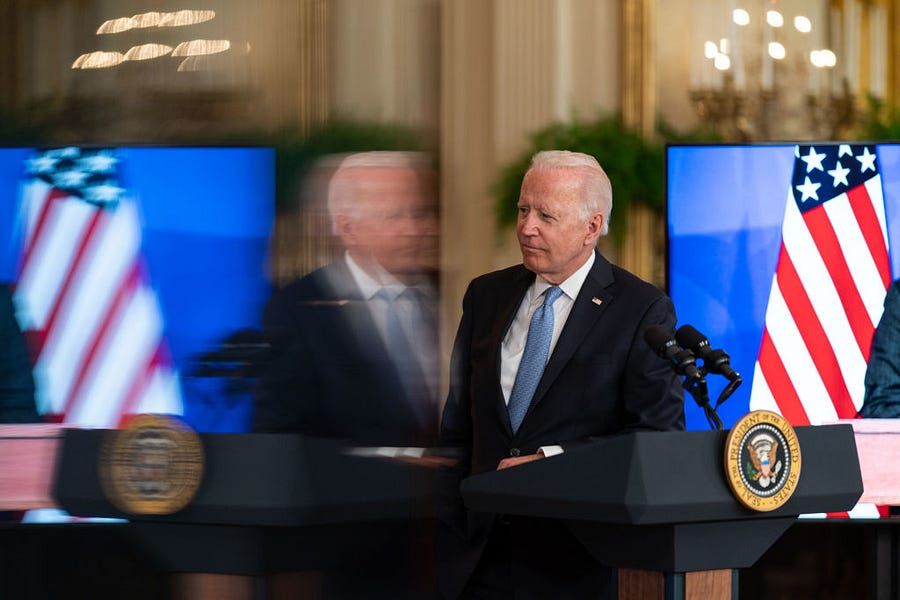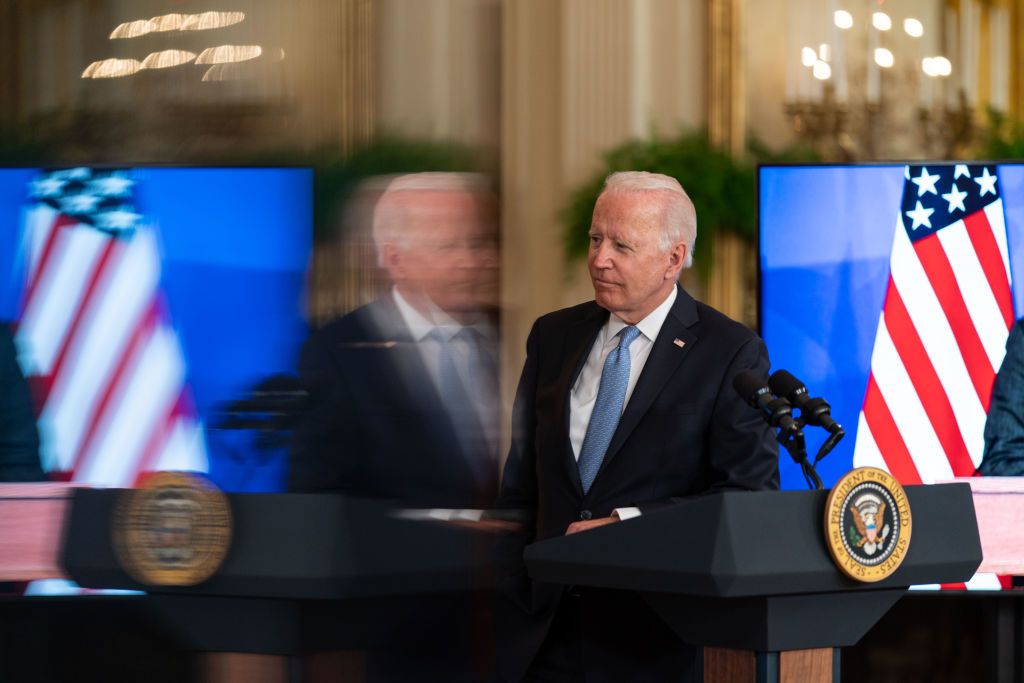‘A More Sustainable And Agile Counterterrorism Approach’
An overlooked speech by Joe Biden’s White House homeland-security adviser points to a return to the Sustainable War on Terror. It looks like we’re at the end of the war’s end.


Edited by Sam Thielman
SURVEILLANCE, LOCAL PROXIES, and the “judiciou[s] use [of] military tools” will define President Biden’s “more sustainable” War on Terror, according to a recent and largely overlooked speech from Elizabeth Sherwood-Randall, Biden’s homeland security adviser.
The White House, per sources of mine, has decided not to release until next year the results of a counterterrorism policy review presently underway. I was surprised by that, as I expected the review to contextualize the Afghanistan withdrawal and coincide with the 9/11 anniversary. While these reviews are a typical feature of a new administration, the delay is especially questionable now, since most everyone in the relevant positions in Biden’s administration, the military, and the intelligence agencies has deep experience with counterterrorism—with the arguable exception of Sherwood-Randall herself, whose background is deeper in nuclear issues and European defense. (This isn’t shade. I’ve benefited from her expertise as part of a 2018 Belfer Center seminar for journalists on nuke stuff.) Still, we will have to wait until the results of the review to draw sharp conclusions about counterterrorism under Biden.
But Sherwood-Randall’s speech to the Atlantic Council on Sept. 8 is likely a preview. One of the questions I’m asked most frequently in podcast (and other) interviews is whether Biden’s Afghanistan withdrawal is the beginning or the end of his War on Terror divestment. Usually I say some version of what I said in the previous paragraph: we’ll know more definitively next year; but the early signs are that this is the end of the end of the wars. Sherwood-Randall drives that home better than I could.
In REIGN OF TERROR—which is in bookstores now and which even The Economist says possesses “a percussive drive that makes it a bracing, infuriating read” and will “make readers see the past 20 years differently”—I trace the liberal penchant for an inconspicuous, technocratic approach to counterterrorism that I call the Sustainable War on Terror. Sherwood-Randall’s speech is thoroughly in this tradition. She even calls the approach “sustainable.”
She outlines a global conflict that exists as the resting state of the U.S. “national security” posture, but not one that drives it. Her “more sustainable and agile” counterterrorism approach—I appreciate her formulation and take vindication from it—“integrates” counterterrorism into “the broader set of national security challenges we face.” She says these challenges range from “a more aggressive China, to cyber attacks, to pandemic disease and bio threats.” While Sherwood-Randall claims this will require “set[ting] priorities,” by which she means diminished money and attention, she doesn’t outline any “hard choices” guiding such alleged rebalance beyond leaving Afghanistan. That suggests that the real rebalance is simply decision-maker prioritization—budgets, staffing—rather than changed material circumstances, like withdrawal, for most operational aspects of global counterterrorism. To borrow an insight from Kerry Howley in New York recently, this is how the War on Terror becomes a routine aspect of American foreign policy.
Under Sherwood-Randall’s framework, the U.S. military will no longer be “the option of first resort,” a promise familiar from the Obama administration. Biden will “judiciously use military tools in our counterterrorism efforts,” she offers, but when possible will prefer an indirect approach. Sometimes that won’t be possible, she signals. Afghanistan is the only specific theater she mentions, and she does so to distinguish between the ground war (the past, unnecessary, wasteful) and “over-the-horizon options,” the latest euphemism for drones (the future, sensible, Sustainable).
The new rhetoric is a quintessential example of how the national-security apparatus somehow considers only ground war to count as capital-W War, while things like airstrikes and commando raids count as alternatives to capital-W War. I’ll leave aside the irony of 9/11 being airstrikes that the U.S. treated as an act of war so as not to get frustrated and stress-eat.
Surveying the 2021 terrorism landscape, Sherwood-Randall sees an “ideologically diverse and geographically diffuse” picture. It’s a technocratic depiction of a War on Terror that leads to the same place the Bush-era theological depiction did: a global battlefield. Al-Qaeda and ISIS “have expanded across Africa and into Southeast Asia,” an ominously expansive portion of the planet that the Biden administration views as a wide theater of conflict that it doesn't quite consider War. Conspicuously, this is also the portion of the planet where China is expanding its influence.
When possible, the U.S. will “wor[k] with local partners in regions in which terrorism is unfortunately spreading. We will need to invest in building their capacity to prevent violent extremism.” This is one of the greatest continuities in the War on Terror—and shows the War on Terror’s continuity with Cold War anticommunism—and yet it’s also portrayed as an alternative to War. While the U.S. military has in particular treated “Building Partner Capacity” as a way to work itself out of a counterterrorism job, in reality, “Building Partner Capacity” is a brutal instrument. The Partners here are Iraq’s death squads, and Afghanistan’s death squads, and Somalia’s death squads, and Mali’s coupists, and Kenya’s death squads, and you get the idea. You also get the idea of what capacities the U.S. is building, whatever Washington’s intentions.
At home there are “racially or ethnically motivated violent extremists, including those promoting the superiority of the white race.” About them, Sherwood-Randall says little beyond the boilerplate of deradicalization and rehashed Department of Homeland Security “community-based approaches,” like “safe new ways that family, friends, and co-workers can share information when they have concerns that someone they know is becoming radicalized.”
On one level, “community-based approaches” updates the Obama-era Countering Violent Extremism approach, which was vastly more coercive and intrusive than Obama portrayed. On another, what Muslims continue to face in this country—ongoing law enforcement and immigration suspicion, terrorism watchlists you can never escape, entrenched political and journalistic delegitimization of Muslim political perspectives—is not the voluntary “safe new ways… [of] sharing information” described here. The fundamental problem here is that white terrorism enjoys a degree of elite political sympathy that you can see from GOP congressmembers’ blocking and tackling for the January 6 Capitol insurrection and more besides. Treating this as a security problem more than an urgent political problem—that specific urgent political problem—is a tragic mistake foretold.
While this-or-that operation within the War on Terror may be expendable, Sherwood-Randall makes clear there will be no rollback of the expanded, entrenched post-9/11 apparatus of intelligence broadly—and surveillance specifically:
A sustainable counterterrorism approach must be flexible enough to respond to threats as they emerge. This necessitates having a fully developed Indicators-and-Warning architecture to detect and identify threats before they reach an inflection point that threatens our Homeland and our citizens. Even though we judge that the threat of large-scale attacks against the homeland is currently diminished, we must remain vigilant – and intelligence will be key. A threat that revolves around people and networks is inherently challenging to detect, so we must continue to support the intelligence enterprise and ensure that it has sufficient resources to perform its vital counterterrorism role.
Sherwood-Randall leaves a significant amount unsaid in her speech. There’s no mention of Iraq, where 2,500 U.S. forces remain; no mention of Syria, where 900 and probably more U.S. forces remain; no mention of Kenya or Djibouti, where the stuff for the Somalia war got moved; no mention of Yemen, where a U.S.-backed war proceeds despite Biden’s claim of ending it; no mention of the proxy conflicts with Iran; on and on. These operations will not wither away through lack of high-level attention. The very clear lesson of Obama and Trump’s presidencies is that the Forever Wars do not conclude without active decisions to conclude them. Rendering them inconspicuous—the ambition of the security technocrat and the politicians that align with security technocrats—perpetuates them. All this talk about “agility” and “flexibility,” mantras of the Security State for as long as I can remember covering it, means, in practice, expansion with fewer bureaucratic restraints.
Perhaps most worrisome is that Sherwood-Randall presents the War on Terror as having largely worked. “We have had significant success,” she said, by which she means the U.S. doesn’t face another 9/11 (“reduced the threat of large-scale attacks on the Homeland directed by foreign terrorist organizations”), something that was always an exception in the annals of terrorism. She continues: “We have a strong and effective counterterrorism enterprise that collaborates and innovates across the Federal government, with state and local colleagues, with the private sector, and with allies and partners around the world.”
If success is measured in terms of the construction of a state of exception and the mechanisms to enforce it, then sure. But if success is measured in human lives and human freedom, then to cheer the triumphs of the War on Terror is to make an appalling moral judgment, one so uncontroversial within certain national security circles as to make it seem like it isn’t being made at all.
I FEEL WEIRD about self-promotion. But tonight I’ll be on Late Night with Seth Meyers, which is why I mentioned earlier trying not to stress-eat. And I expect to make an announcement that I will very likely be discussing in this newsletter frequently.

